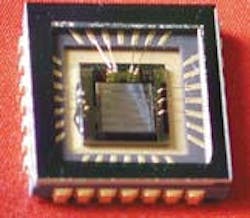MOEMS bolometer may provide cost-effective optical gas sensing
Engineers at Ion Optics (Waltham, MA) and researchers at the Jet Propulsion Laboratory (JPL; Pasadena, CA) have collaborated to develop a micro-optical electromechanical system (MOEMS) device for carbon dioxide sensing, intended to bring the performance advantages of optical technology down into the cost range of existing electrochemical methods.
Even though electrochemical sensors are small, sensitive, inexpensive, and have low power requirements, their accuracy can be compromised by the fact that they must come in contact with the environment being measured, according to Edward Johnson, president and CEO of Ion Optics, who described the new device in October at a symposium on micromachining and microfabrication held in San Francisco, CA by the International Society for Optical Engineering (SPIE; Bellingham, WA). The proposed optical solution essentially consists of a bolometer based on a finely tuned infrared source and a highly temperature-sensitive semiconductor detection system. The device performs nondispersive infrared spectroscopy without incurring the cost of a diode laser.
"One of our goals was to make a low-cost, poor man's laser diode, so to speak," said Thomas George, supervisor of the MOEMS technology group at JPL that worked with Ion Optics. "We wanted a highly sensitive device that could sense PPM (parts per million) levels of gases."
The gas-sensing device essentially consists of a suspended filament of single-crystal silicon within a cavity that acts as its own bolometer (see figure). The efficiency with which the cavity reflects infrared radiation back to the filament source, and hence the resistance of the filament, is sensitive to the contents of the cavity. Patterning the filament using electron-beam lithography effectively narrows the emission band of the filament from the expected blackbody profile to provide a sharp peak near the 4.3-µm absorption sensitivity of carbon dioxide. Exponential variation of resistance with temperature provided by the single-crystal silicon (as opposed to the linear response of traditional metal bolometers) enhances the sensitivity of the device.
Johnson approached JPL a couple of years ago to help develop the gas-sensing bolometer concept based on a metal surface locally tuned to the desired wavelength. George suggested the single-crystal silicon material, because of its exponential temperature sensitivity, suggesting lithographic patterning for the emission and absorption tuning. Once Johnson and George had articulated the device concept, engineers at Ion Optics performed the device design and testing, JPL researchers provided fabrication expertise, and microwave-mesh theory research from the University of Iowa (Iowa City, IA) provided theoretical background for the device. "Ed Johnson put together a wonderful team," George said.
Luck also played an important role. "We started out with some assumptions that were not quite correct," said Gauer. "We were looking at two-dimensional photonic band-gap theory, but it was basically a surface plasmon coupling. The fact that the surface plasmons coupled to give us this really nice absorption feature was truly a stroke of luck. The properties matched just right. Starting from first principles you wouldn't have predicted that."
"Both Ion Optics and we [at JPL] learned a good bit in this project. The satisfying thing was to see a real live product at the end of the day," George said.
About the Author
Hassaun A. Jones-Bey
Senior Editor and Freelance Writer
Hassaun A. Jones-Bey was a senior editor and then freelance writer for Laser Focus World.
